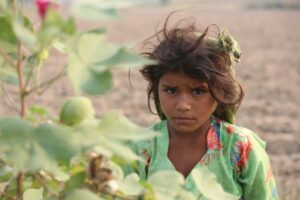Rajkumari Sharma Tankha
Life in the Shadows, an exhibition of photographs by Chitvan Gill currently on at Art Gallery, Kamaladevi Complex, India International Centre, New Delhi brings to fore the unseen children of India’s poor forced to work due to poverty. “This exhibition is an attempt to bring these children closer to us, it tells of their struggle for existence; it is the story of their parents, the marginalised, the poorest of the poor,” says Gill. There are 81 pictures in this exhibition, culled out from hundreds of pictures clicked by Gill, taken over a period of three months in the latter part of 2021. Born and brought up in Assam, Gill moved to Delhi in 1983, after her IPS father was posted here, and has lived here ever since. Excerpts from an interview:
What explains your special interest in clicking kids? Whom is this show targeted at?
My work focuses particularly on development, poverty, migration and related issues. This particular project was part of a series of programmes to focus on the International Year for the Elimination of Child Labour, and I was approached by a group, Work: No Child’s Business, which has as its principal purpose the elimination of child labour. The aim was to target audiences beyond the world of seminars and conferences where this issue is normally discussed, to create wider awareness and, hopefully, add to the pressure for change.

Do you have other subject areas or you only click kids?
I have worked on old Delhi, the river Yamuna, on Buland Masjid, a slum colony in East Delhi, on handloom weavers in Delhi, on a traveling circus, on seasonal Kashmiri migrants, among many other subjects.
I try not to limit my subject matter to any one thing, though much of my work does concentrate on the marginalized and the neglected segments of the population.
Do you always select a theme first and click later, or you click and then categories these pictures?
No, I work on whatever excites my interest at a particular time, and engage with a single subject or theme. I do, of course, take occasional photographs of opportunity, but these cannot be compiled into a thematic category. My major projects have always been the outcome of concentrated work on a specific theme, usually over extended periods of time. Life in the Shadows, in fact, was executed over relatively the shortest time frame as a result of the need to fit it into the International Year for the Elimination of Child Labour.
How did you enter photography? Who inspires you the most?
I came to photography from documentary film making. It was a hobby for long and I began to use it to enhance and document the stories I was working on. There are too many influences, one of whom is Sebastiao Selgado.
Which was your first camera and your first pic. Which camera do you have now?
My first camera was a Sony Cybershot DSC R1. My current camera is a Canon 4D, Mark III.
What do you do with the photos you click – keep them or donate to libraries/museums?
I keep them.
What would you advise a budding photographer?
Just relax, shoot what you have a passion for, don’t worry, and try to make your subjects comfortable.
What are your other interests – like what do you do in your free time
Reading, watching films, writing, documentary film making.
Exhibition on view till July 14, 11am to 7pm